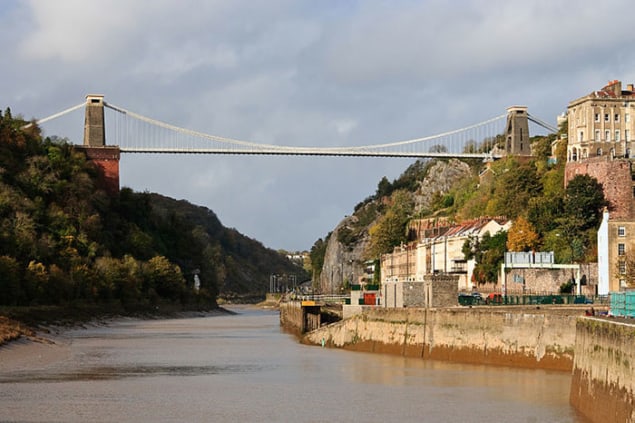
Wobbly footbridges can both delight and terrify pedestrians. Now, researchers in the USA and Russia have developed a model showing how an apparently stable bridge can suddenly show alarming, potentially dangerous wobbles when a certain number of people walk across it.
Designing a footbridge can be a challenge because it can be difficult to predict how a structure will respond to the pounding of many feet at once. The London Millennium Footbridge across the River Thames, for example, opened with great fanfare in 2000, only to close within days after large crowds found the bridge rocking unnervingly as they walked. The bridge remained closed for almost two years while dampers were installed.
Bridges, like any other structures, have natural frequencies of vibration. It is well known that bridges can collapse if large numbers of feet simultaneously excite vibrations at these natural frequencies. The Albert Bridge – built across the Thames in 1873 – bears a sign instructing marching soldiers to break step when crossing. However, ordinary pedestrians do not march in step. Moreover, the Millennium Bridge oscillated left to right, not up and down.
Inadvertent amplification
In 2004 Steven Strogatz of Cornell University in the US, and international collaborators, modelled pedestrians on a bridge as coupled oscillators to show how, if a bridge does begin to vibrate naturally, pedestrians can fall into step with the vibrations to maintain their balance. In doing so, they inadvertently amplify the oscillations. This is analogous to the famous model, first developed by the Dutch physicist Christiaan Huygens in 1665, of pendulums suspended from the same beam becoming synchronized in phase because of motion transmitted through the beam.
Strogatz’ model has been highly influential in the applied mathematics community, but it cannot provide precise, quantitative predictions of the conditions under which a given bridge will wobble that could be used for computer modelling in the design of bridges. “The existing industry programs used to develop bridges are based on linear calculations,” explains Igor Belykh of Georgia State University in the US. “These are very outdated and cannot capture highly non-linear phenomena like this switching to larger wobbling as a result of very complicated two-way interactions between the pedestrians and the bridge.”
Belykh and colleagues in Russia combined crowd synchronization and bridge dynamics with a biomechanical model of walking humans as inverted pendulums pressing alternately on the ground with left and right feet. They considered many such pendulums on the bridge at once, with a range of frequencies and phases, and formulated two nonlinear differential equations for the amplitude and phase of the bridge’s oscillations.
Pendulum crowd
The researchers showed that, above a specific critical number of pendulums, a stable solution can appear in which the oscillators all fall into phase and the amplitude suddenly increases: “We were able to give specific estimates of the relationship of this critical size to the natural frequency of the bridge, to the mass of the bridge and to the natural frequency of human walking,” says Belykh. The model predicted oscillations of the Millennium Bridge would occur when more than around 165 people walked on it at once – matching the experimental findings of the engineering company Arup, who designed and fixed the bridge. In future, says Belykh, the work could predict whether the anticipated number of pedestrians using a planned bridge will cause problems, and whether additional dampers or other design modifications are needed. The researchers also developed a more mathematically abstract model that gives very similar predictions and can be solved analytically.
Questions remain, however, and it is uncertain how phase synchronization arises initially. For example, the Clifton Suspension Bridge in Bristol, UK, was closed to large crowds after it developed oscillations when thousands of pedestrians surged across it during the city’s annual Balloon Fiesta. However, the oscillation frequency of this bridge was different from the average pedestrian’s frequency and people did not fall into phase when crossing. The researchers are now investigating these phenomena in collaboration with John Macdonald and colleagues at the University of Bristol, who originally developed the inverted pendulum model.
Adilson Motter of Northwestern University in Illinois says the work fits into a body of complex systems research on bridges and synchronization phenomena that followed the Millennium Bridge affair: “A key step here is that they model what a person is on a bridge that is not very stable and try to understand how the person interacts with the bridge response,” he says.
Moving forward
Henk Nijmeijer of the Technical University of Eindhoven in the Netherlands agrees that “it’s a very interesting [piece of work] that brings together aspects of crowd dynamics and wobbly bridge dynamics, and there is still a lot that’s not well understood”. He notes, however, that, in using inverted pendulums to model the pedestrians, the researchers have ignored the crucial fact that pedestrians cross a bridge: “Pendulum clocks are not supposed to walk from left to right or right to left,” he says. “If you miss in the walker the forward motion which must be there, there is something weird in the model.”
The research is described in Science Advances.



